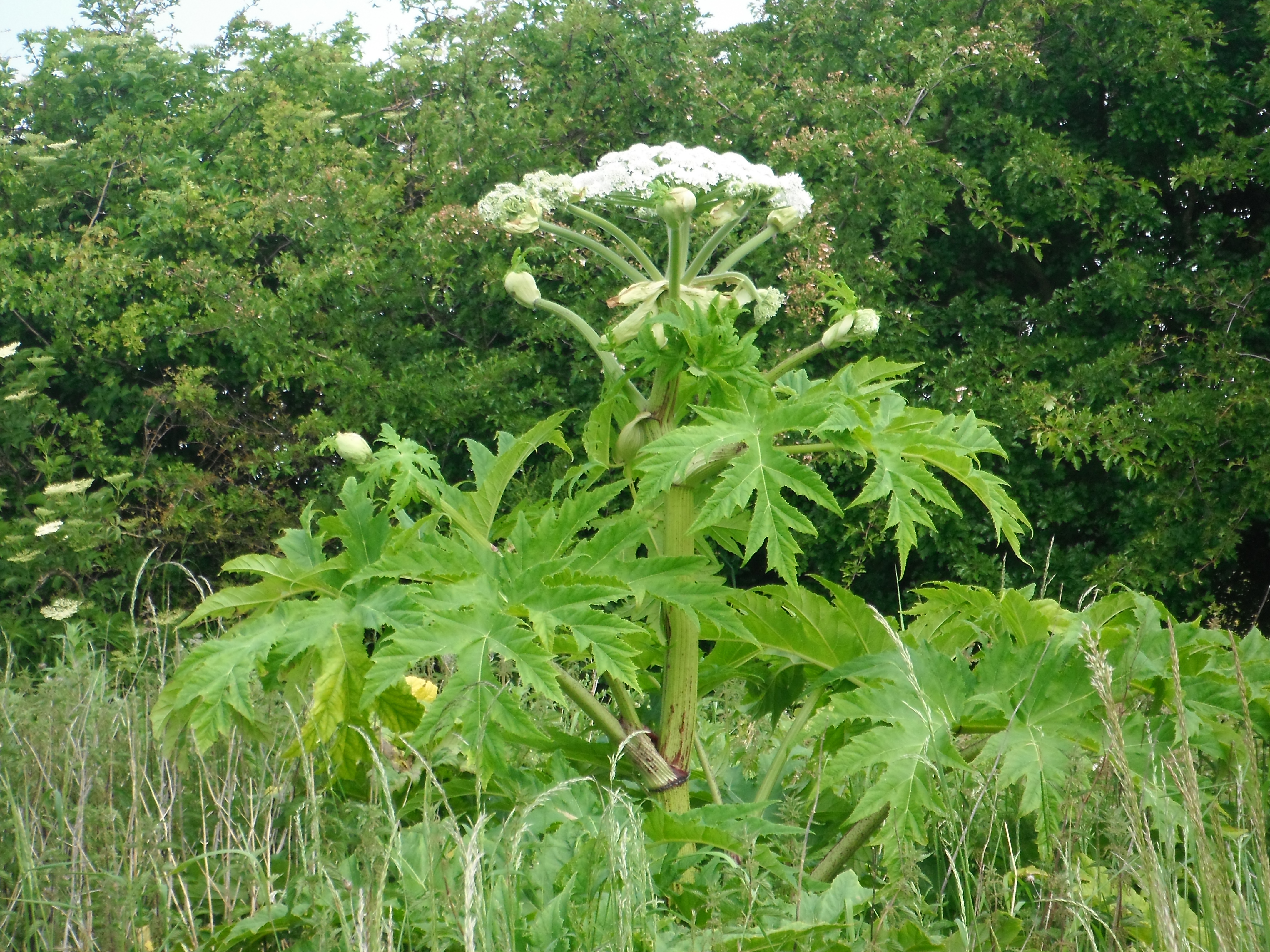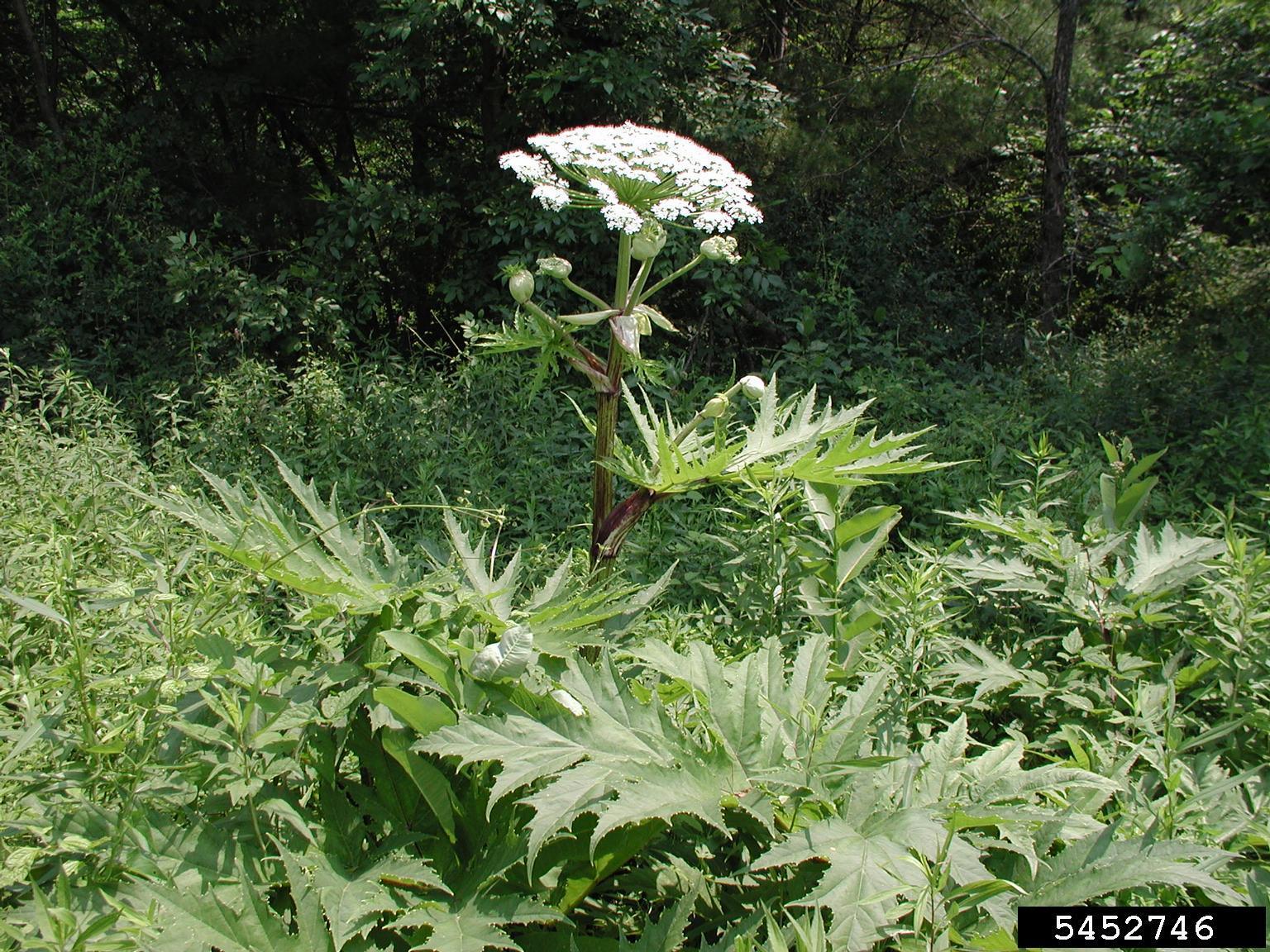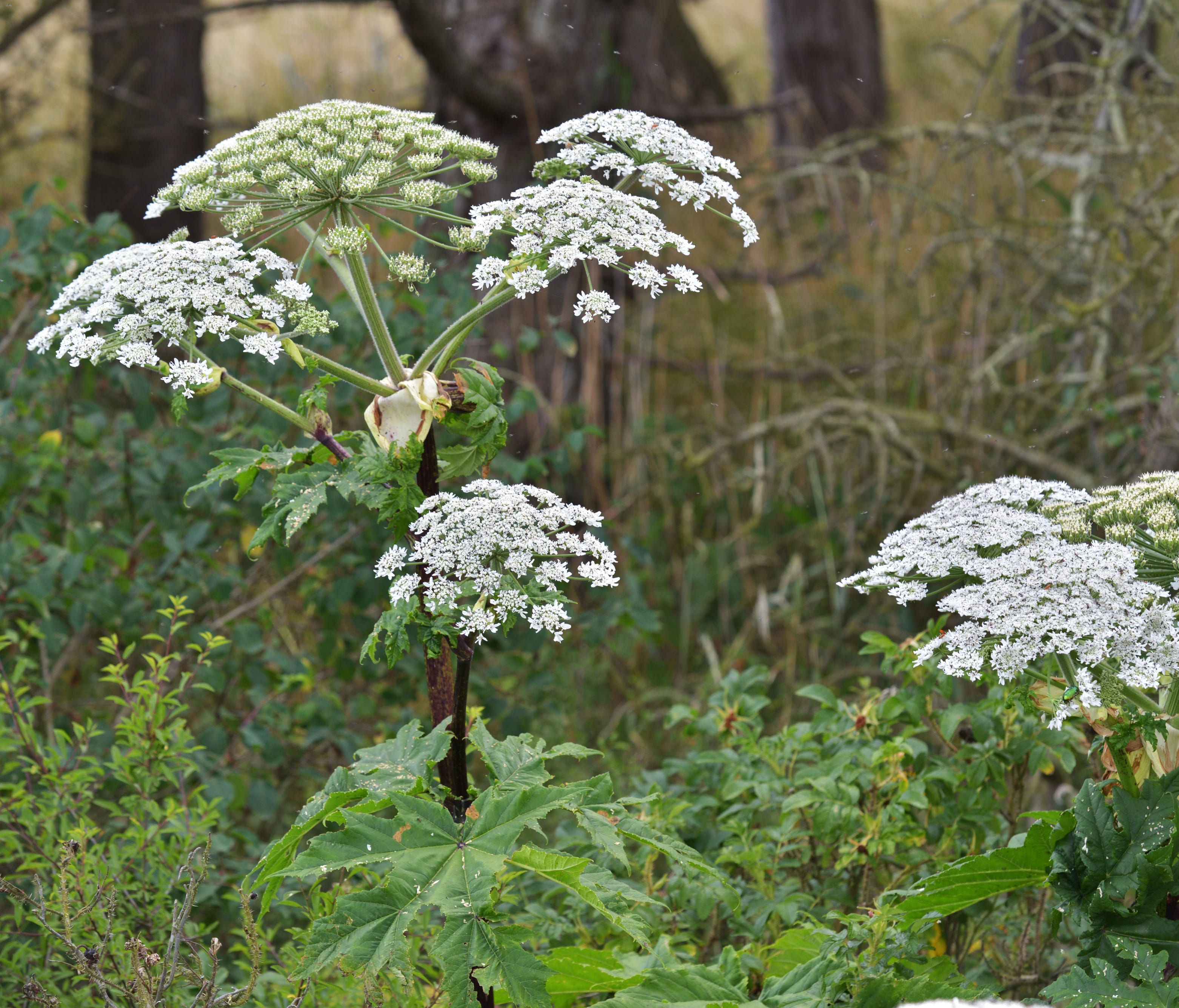Botanical Description
Giant hogweed (Heracleum mantegazzianum) is a colossal herbaceous perennial belonging to the carrot family (Apiaceae). It’s a towering botanical marvel that commands attention with its exceptional physical characteristics.
This formidable plant can reach heights of up to 20 feet (6 meters), casting an imposing presence in its surroundings. Its robust, hollow stem stands erect, adorned with coarse, bristly hairs. The stem’s diameter can measure up to 4 inches (10 centimeters), resembling a sturdy pillar.
Leaves
Giant hogweed’s leaves are equally impressive, displaying a remarkable size and complexity. They’re compound, consisting of several leaflets arranged in a palmate pattern. Each leaflet can reach a length of 3 feet (1 meter) and a width of 2 feet (0.6 meters), creating a massive, umbrella-like canopy.
Flowers
During the summer months, giant hogweed blooms with clusters of tiny, white flowers. These flowers are arranged in large, flat-topped umbels, measuring up to 2 feet (0.6 meters) across. The umbels consist of numerous small florets, each with five petals and a central dark purple stigma.
Giant hogweed, a menacing plant, can cause severe burns upon contact. Its towering stature and toxic sap pose a significant threat to unsuspecting individuals. In contrast, the Nigel Sharkey Ward stands as a beacon of hope for victims of giant hogweed burns, providing specialized treatment and support.
Their unwavering dedication to mitigating the effects of this dangerous plant is a testament to their unwavering commitment to patient care.
Growth Patterns and Habitats
Giant hogweed is an aggressive invader, capable of forming dense stands that can dominate entire ecosystems. It thrives in moist, fertile soils and prefers open, disturbed areas such as roadsides, riverbanks, and wastelands.
Origin and Distribution: Giant Hogweed
Giant Hogweed, a towering and invasive plant, traces its origins to the Caucasus region, which encompasses parts of Eastern Europe and Western Asia. Its native range extends across countries such as Georgia, Armenia, Azerbaijan, and southern Russia.
Over time, Giant Hogweed has spread far beyond its native borders, establishing itself as an invasive species in numerous regions worldwide. This expansion has been facilitated by several factors, including the transportation of seeds via human activities, such as trade and travel. The plant’s hardiness and adaptability have also contributed to its successful establishment in new areas, where it often outcompetes native vegetation and disrupts local ecosystems.
Medicinal Properties and Uses

Giant Hogweed possesses various medicinal properties, making it a versatile herb in traditional and modern medicine.
Traditionally, its roots, leaves, and stems have been used to treat various ailments, including wounds, burns, skin infections, and digestive issues.
Active Compounds
The therapeutic effects of Giant Hogweed are attributed to the presence of several active compounds, including:
- Furocoumarins: These compounds are responsible for the plant’s photosensitizing properties, making it effective in treating skin conditions.
- Phenolic acids: These compounds exhibit antioxidant and anti-inflammatory properties.
- Polysaccharides: These compounds have immunomodulatory effects and support the immune system.
Potential Health Benefits
Giant Hogweed has demonstrated potential health benefits, including:
- Antimicrobial activity: The plant’s extracts have shown effectiveness against various bacteria and fungi.
- Antioxidant properties: The phenolic acids in Giant Hogweed protect cells from oxidative damage.
- Wound healing: The plant’s extracts promote wound healing by stimulating collagen synthesis and reducing inflammation.
Potential Risks, Giant hogweed
Despite its medicinal properties, Giant Hogweed also poses potential health risks:
- Photosensitivity: Contact with the plant’s sap can cause severe burns and blisters when exposed to sunlight.
- Skin irritation: The plant’s trichomes (small hairs) can cause skin irritation and dermatitis.
- Ingestion: Consuming Giant Hogweed can lead to nausea, vomiting, and other gastrointestinal issues.
Toxicity and Health Hazards

Giant hogweed poses significant health risks due to its toxic sap. This sap contains several toxic principles, including:
- Furocoumarins: These compounds absorb ultraviolet (UV) radiation from sunlight and trigger a severe skin reaction.
- Anthralins: These compounds can cause skin irritation and blistering.
- Polyacetylenes: These compounds have antifungal and antibacterial properties but can also cause skin irritation.
Symptoms and Health Consequences of Exposure
Contact with giant hogweed sap can cause a range of symptoms, including:
- Immediate skin irritation, redness, and swelling
- Blistering and ulceration within 24-48 hours
- Severe pain and burning sensation
- Hyperpigmentation (darkening of the skin)
- Phytophotodermatitis (severe skin reaction caused by exposure to sunlight after contact with sap)
- Eye irritation, including pain, redness, and swelling
- Respiratory problems if sap is inhaled
In severe cases, exposure to giant hogweed sap can lead to permanent scarring, blindness, and even death.
Safe Handling and First Aid Measures
To prevent exposure to giant hogweed sap, it is essential to:
- Wear protective clothing, including gloves, long sleeves, and pants.
- Avoid contact with the plant, especially during sunny weather.
- If contact occurs, immediately wash the affected area with soap and water for at least 15 minutes.
- Cover the affected area with a bandage or gauze to protect it from sunlight.
- Seek medical attention if symptoms are severe or do not improve.
By following these guidelines, you can minimize the risk of exposure to giant hogweed sap and its associated health hazards.
Environmental Impact

The invasion of Giant Hogweed poses significant ecological threats. Its rapid growth and competitive nature disrupt ecosystems, outcompeting native vegetation and altering the natural balance.
Giant Hogweed’s tall stems and dense foliage create dense canopies, blocking sunlight and inhibiting the growth of other plants. This reduces biodiversity, as many native species cannot thrive under the shade of Giant Hogweed. Additionally, its allelopathic properties release chemicals into the soil that suppress the germination and growth of neighboring plants.
Challenges and Control Methods
Controlling the spread of Giant Hogweed is a complex task due to its adaptability and resilience. Mechanical removal involves cutting or mowing the plants, but this must be done carefully to avoid contact with the sap. Chemical herbicides can be effective, but they require repeated applications and can have negative impacts on non-target species.
Biological control methods, such as introducing insects or pathogens that specifically target Giant Hogweed, have shown some promise. However, these methods require extensive research and testing to ensure they do not harm other native species.
Giant hogweed is a menacing plant that poses a significant threat to human health. Its toxic sap can cause severe burns and blistering, making it a dangerous encounter for unsuspecting individuals. While the giant hogweed is a formidable foe, it is not the only invasive species that poses a risk.
The eiropean hornet , an aggressive and venomous insect, has also established a foothold in many regions. Like the giant hogweed, the eiropean hornet can inflict painful stings that can cause allergic reactions and, in severe cases, even death. Therefore, it is crucial to remain vigilant against both the giant hogweed and the eiropean hornet, taking necessary precautions to avoid contact and minimize the potential risks they pose.
Early detection and rapid response are crucial to prevent the establishment of Giant Hogweed populations. Public awareness and education are essential to reduce accidental introductions and promote responsible disposal of plant material.
Prevention and Management
Preventing the spread of Giant Hogweed and managing existing infestations are crucial to protect human health and ecosystems. Effective prevention and management strategies involve a combination of chemical, biological, and mechanical techniques.
Beware of the towering Giant Hogweed, a plant so dangerous it can cause severe burns. Unlike the recent helicopter crash in Iran , which claimed the lives of high-ranking officials, Giant Hogweed’s deadly sap poses a different kind of threat.
Its toxic compounds can lead to painful blisters and long-term scarring, a reminder of the hidden perils that lurk in nature.
Prevention
Implementing proactive measures to prevent the spread of Giant Hogweed is essential. The following table Artikels effective methods:
| Method | Description |
|---|---|
| Early Detection and Removal | Regularly monitor areas for Giant Hogweed plants. Remove and destroy any identified plants before they produce seeds. |
| Seed Dispersal Prevention | Prevent seed dispersal by cutting or mowing Giant Hogweed plants before they flower. Dispose of plant material responsibly to avoid spreading seeds. |
| Seed Bank Management | Control the spread of Giant Hogweed by preventing seed germination. Apply herbicides to target seed banks and reduce future infestations. |
| Habitat Modification | Alter the habitat to make it less suitable for Giant Hogweed growth. Remove dense vegetation, improve drainage, and increase sunlight exposure. |
Management
Controlling existing infestations of Giant Hogweed requires a comprehensive management plan. Here’s an Artikel:
- Assessment and Monitoring: Determine the extent and severity of the infestation. Monitor the site regularly to track progress and adapt management strategies as needed.
- Chemical Control: Use herbicides specifically formulated for Giant Hogweed control. Apply herbicides according to label instructions, taking precautions to avoid harm to non-target organisms.
- Biological Control: Introduce natural enemies, such as the Hogweed Hawk Moth, to feed on Giant Hogweed plants. This method is still under research and development.
- Mechanical Control: Physically remove Giant Hogweed plants by digging them up or cutting them down. Ensure proper disposal of plant material to prevent seed dispersal.
- Integrated Pest Management: Combine multiple control techniques to maximize effectiveness and reduce the risk of resistance. Implement a long-term management plan to prevent re-infestation.
Cultural Significance and Folklore
Giant Hogweed has played a minor role in human culture and folklore. It has been used in traditional medicine and its sap has been employed in art and literature.
Use in Traditional Medicine
In some regions, Giant Hogweed has been traditionally used as a treatment for skin conditions, wounds, and burns. The plant’s sap contains a substance called furanocoumarin, which has antibacterial and antifungal properties. However, the use of Giant Hogweed for medicinal purposes is not recommended due to its potential toxicity.
Use in Art and Literature
The large, distinctive leaves and flowers of Giant Hogweed have made it a popular subject for artists. The plant has been depicted in paintings, drawings, and photographs. Giant Hogweed has also been mentioned in literature, including the novel “The Giant Hogweed” by John Wyndham.
Illustrations and Images
Giant Hogweed is an imposing and distinctive plant with an appearance that is both captivating and alarming. Its towering stature and menacing features have earned it a place among the most recognizable and feared invasive species worldwide.
Plant Structure
Giant Hogweed belongs to the Apiaceae family, which also includes familiar plants such as carrots and parsley. It exhibits a robust and sturdy structure, with a thick, hollow stem that can reach heights of up to 15 feet (4.5 meters). The stem is covered in coarse, stiff hairs that provide a rough texture and give the plant a menacing appearance.
At the base of the plant, large, deeply lobed leaves form a dense rosette that can spread up to 5 feet (1.5 meters) in diameter. These leaves are deeply divided into leaflets with serrated edges, resembling the jagged leaves of a thistle. The leaves are a vibrant green color, adding to the plant’s imposing presence.
Inflorescence and Flowers
The most striking feature of Giant Hogweed is its massive inflorescence, an umbrella-shaped cluster of tiny white flowers. This inflorescence can grow up to 2 feet (0.6 meters) in diameter and contains hundreds of individual flowers. The flowers are small and inconspicuous, but their sheer number and arrangement create a dramatic visual effect.
The flowers of Giant Hogweed are pollinated by insects, particularly hoverflies and wasps. After pollination, the flowers develop into flat, oval-shaped seeds that are about 1/4 inch (6 millimeters) long. These seeds are light brown in color and have a distinctive ribbed texture.
Roots and Rhizomes
Giant Hogweed possesses a deep and extensive root system that anchors the plant firmly in the ground. The taproot can penetrate the soil up to 10 feet (3 meters) deep, providing the plant with access to water and nutrients. In addition to the taproot, Giant Hogweed also produces a network of rhizomes, which are underground stems that spread horizontally and produce new plants.
Overall Appearance
The overall appearance of Giant Hogweed is one of size, menace, and beauty. Its towering height, menacing stem, and massive inflorescence make it an unforgettable sight. The combination of its distinctive features and its potential for harm has made Giant Hogweed a plant that is both admired and feared.